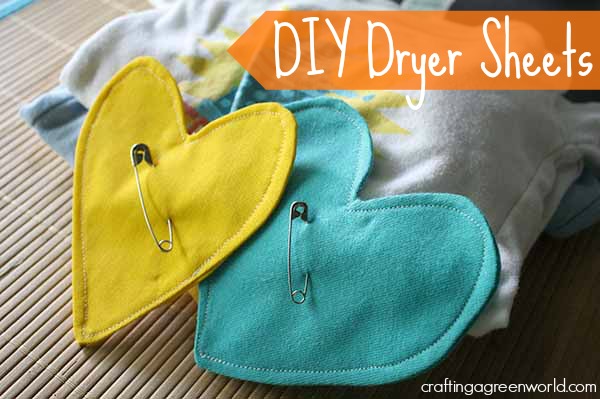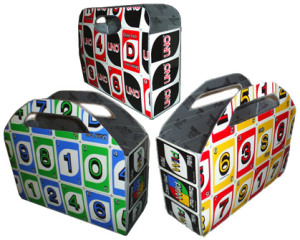
Have you been wanting to ditch the toxic dryer sheets? My husband and I came up with a homemade dryer sheet replacement to keep us static-free without harsh chemicals!
My husband Dave can’t stand even a little bit of static. Even in summer he is uncomfortable! We have been trying for years to stop using toxic dryer sheets for good, and we finally found something that works! We have tried all manner of store-bought dryer balls to no avail, but the homemade hearts pictured above are doing the trick!
Related Reading: Extreme Upcycling: A Dress Made from Dryer Sheets
Until about a year ago, we were still using dryer sheets, and it made me so sad. Every natural anti-static solution we tried just wasn’t good enough. Then, last August I found out that I was pregnant and along with not changing the litterbox anymore, I decided it was time to ditch those dryer sheets for good. Coating our own clothes in toxins was one thing, but there was no way I was going to expose our little one to potential carcinogens and endocrine disruptors.
Ditching those nasty dryer sheets for good really amped up our search, and after a lot of digging, Dave found something that works! Click here for the homemade dryer sheet tutorial!






Are the pins to help you find them in the laundry? What is the vinegar for in the washing machine?
The hearts are to help you find the safety pins. It’s the metal that does the thing. I’m not sure how the vinegar works, but it does help reduce static some. They work separately, so I do both for a double whammy. 🙂
This looks interesting, but I’m unclear what purpose the sheets serve — I use a vinegar when I wash my clothes anyway. What does putting these sheets in the dryer add to that?
It has something to do with the safety pins, and like I say in the post I am not sure *why it works*. It has made a big difference for us, though!
That was supposed to say “a vinegar rinse”.
are you supposed to soak the dryer sheets in vinegar? otherwise it seems pointless just putting the dryer sheets in!
I was wondering the same thing! 🙂 Maybe a sentence or two about how and why this works could be added? Thanks!
This tip was just shared by EverydayRoots on Facebook and ALL of the comments there are asking the same question…
I just made a heart dryer sheet. I made it bigger than yours with an inner ply of old toweling since the scrap of fabric I used was sort of wimpy. I put several safety pins on mine – 3 on one side and two on the other side. I plan to put a couple of drops of lavender oil on it to make our clothes smell nice. Oh! I also added a loop in the stitching so I can hang it up when not in use. I plan to make a bunch more for our daughter and 2 daughter-in-laws. Thanks for the idea. jax in CO
I would love to see a photo – that sounds awesome!
This seems awesome! I would love to know more about the science behind it. Is the metal in the safety pin somehow reacting with the vinegar rinse in the clothes?
I’m curious as well. What is it about scrap fabric hearts makes them combat static? Do you soak them in anything before tossing them in the dryer? Otherwise, I don’t see how they would be any different from all the other fabric getting static-y as it tumbles about my dryer.
I’d really love to find a natural solution that actually works. My daughter is allergic to any commercial fabric softener I’ve tried – eco or otherwise. We live in a very dry climate. We currently use the wool dryer balls, but even then, the clothes are still static-y.
Oh the hearts are just for cute, and so that you can find the safety pins when you’re folding your wash.
I used two metal ones and it didn’t work. I did a load with a ball of tinfoil instead to see if that did the trick. IF it did, I’ll have to cover my heart in safety pins and try it again. Your way is so much cuter than a ball of foil. I really want it to work!
Oh that is sad to hear! Let me know how it goes with more pins! I wonder if it depends on how dry your weather is? We get pretty dry winters, but not as dry and cold as places up north (I’m in Atlanta).
Tin foil ball didn’t work! Boo! I’m assuming more safety pins won’t either. I’m in Southern Wisconsin. Cold & VERY dry right now. Everything is staticy. Maybe this will work in the summer for me. But, in the mean time I’m still on the search for a natural alternative that works.
I am so bummed about this! I’ll keep an eye out too. If you find something, I’d love if you’d let us know, so I can do a follow-up!
My guess as to why this works would be that the vinegar helps to soften clothes (one purpose of regular dryer sheets) and the safety pin helps to attract the electrons that otherwise accumulate in your clothes due to the motion of the dryer (tumbling in a metal drum = transfer of electrons) and this eliminates the static cling (the other purpose of conventional dryer sheets).
I like it, Jill!
Thanks for this. It will be in my washer/dryer routine as of tonight. i just had a thought, though. Vinegar works great as a whitener & brightener, but what about dark clothes ? Any brilliant ideas on that score?
I will confess this: I am terrible about separating lights and darks. Everything gets tossed together into the machine. I haven’t noticed our dark clothes fading, and we’ve been using vinegar as a softener for years – long before adding the safety pins into the mix. It’s a relatively small amount of vinegar considering how many gallons of water go into a load of laundry. I think to bleach or lighten you’d need to use a much higher concentration.
I use my washcloths and fabric softener in a plastic juice jar with a tight-fitting lid. Dip part of the clean, damp (from the washer) washcloth in the liquid, wring til damp again, not wet. Toss in the dryer with the clothes. Your wash gets the benefit of “dryer sheets” no waste, nothing extra, and your washcloths smell good too!
Are you talking regular fabric softener or something you make? I’m trying to avoid harsh chemicals, since we have the baby’s stuff in the wash now. If you’re making a mixture, I’d love the recipe!
I wanted to chime in about the dark clothes. I actually find that vinegar is great with dark colors. Whenever I buy a new pair of jeans, especially if they are a dark wash jean, I always try to remember to put vinegar in with them because it prevents fading, but also prevents it from bleeding into the other clothes (which is nice because I am also terrible about separating lights and darks).
My daughters school assistant told her to take a small piece of aluminum foil and ball it up an toss in the dryer with your clothes. It must be something in the metal properties that keep the static at bay. It certainly works but I think the safety pin way would be a better reusable option thanks for the tip.
This didn’t work for me at all. I used the vinegar in the wash first and then the safety pinned heart in my dryer. I did 4 loads to be sure. No success : (
I wonder if it has something to do with the composition of your safety pins? Here, we’re using the silver ones, but I know they make gold and plastic safety pins, as well–they may not work.
The composition of metal is important, because of the vinegar rinse. Vinegar is an acid, and acids react with some metals, especially when heated up as in the dryer. The reaction releases ions and seems to eliminate static… BUT it depends on the metal. Copper, for instance, is non-reactive, and iron is reactive. But you probably don’t want to stick a bunch of iron nails in your dryer, so we’re going with safety pins, instead.
Did you use one safety pin or two? If you only used one, that would explain it!
Pingback: 10 DIY Green Cleaning Recipes | Care2 Healthy Living
Pingback: 10 DIY Green Cleaning Recipes | Everyfoodrecipes, cooking tips, and how-to food videos—all rated and reviewed by millions of home cooks,make the perfect birthday cake, or plan your next holiday dinner.
Pingback: 10 DIY Green Cleaning Recipes | Magazine On Health
Pingback: 10 DIY Green Cleaning Recipes | Health
I can’t wait to try this. Simple science and no need for toxic chemicals! I love the idea of adding a loop to hang it up.